Antibody data
- Antibody Data
- Antigen structure
- References [0]
- Comments [0]
- Validations
- Western blot [1]
- Immunocytochemistry [3]
- Immunoprecipitation [1]
- Immunohistochemistry [9]
- Other assay [1]
Submit
Validation data
Reference
Comment
Report error
- Product number
- PA5-54183 - Provider product page

- Provider
- Invitrogen Antibodies
- Product name
- Ataxin 2 Polyclonal Antibody
- Antibody type
- Polyclonal
- Antigen
- Recombinant protein fragment
- Description
- Immunogen sequence: EGHSINTREN KYIPPGQRNR EVISWGSGRQ NSPRMGQPGS GSMPSRSTSH TSDFNPNSGS DQRVVNGGVP WPSPCPSPSS RPPSRYQSGP NSLPPRAATP TRPPSRPPSR PSRPPSHPSA HGSPAPVSTM PKRMSSE Highest antigen sequence identity to the following orthologs: Mouse - 93%, Rat - 95%.
- Reactivity
- Human
- Host
- Rabbit
- Isotype
- IgG
- Vial size
- 100 μL
- Concentration
- 0.5 mg/mL
- Storage
- Store at 4°C short term. For long term storage, store at -20°C, avoiding freeze/thaw cycles.
No comments: Submit comment
Supportive validation
- Submitted by
- Invitrogen Antibodies (provider)
- Main image

- Experimental details
- Western blot analysis of Ataxin-2 was performed by loading 10 µg of WT (lane 1) and ATXN CRISPR KO (lane 2) HAP1 cell lysates in RIPA buffer onto a 4-15% gradient polyacrylamide gel. Proteins were transferred to nitrocellulose membrane and blocked in 5% milk. Ponceau stained transfer of blot is shown. Ataxin-2 was detected using an Ataxin-2 polyclonal antibody (Product # PA5-54183) at a dilution of 1:2,000 in 5% BSA in TBST overnight at 4 deg, followed by secondary antibody diluted to 0.2 µg/mL using Goat anti-Rabbit IgG (H+L) HRP antibody (Product # 65-6120). Chemiluminescent detection was performed using Pierce ECL Western Blotting Substrate (Product # 32106). Data courtesy of YCharOS Inc., an open science company with the mission of characterizing commercially available antibodies using knockout validation.
Supportive validation
- Submitted by
- Invitrogen Antibodies (provider)
- Main image
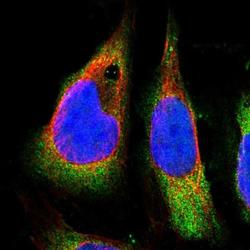
- Experimental details
- Immunofluorescent staining of Ataxin 2 in human cell line U-2 OS shows positivity in cytoplasm. Samples were probed using an Ataxin 2 Polyclonal Antibody (Product # PA5-54183).
- Submitted by
- Invitrogen Antibodies (provider)
- Main image
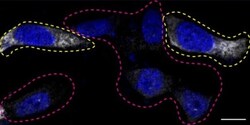
- Experimental details
- Immunofluorescence of Ataxin 2 was performed using parental and Ataxin-2 HAP1 CRISPR KO cells that were transfected with a GFP or mCherry plasmid, respectively. At 48 hrs post transfection parental and KO cells were mixed and plated to a 1:1 ratio on coverslips as a mosaic and incubated for 24 hrs. Cells were fixed in 4% PFA for 15 min and permeabilized with 0.1% Triton X-100. Cells were stained with Ataxin polyclonal antibody (Product # PA5-54183) overnight at 4 deg. Secondary antibody incubation was performed using 1 µg/mL of goat anti-rabbit IgG (H+L) Alexa Fluor 555 secondary antibody (Product # A-21429) for 1 hr at RT. Imaging was performed with a 40X oil objective and analysis was performed using Image J. Cell image represents a single focal plane. Data courtesy of YCharOS Inc., an open science company with the mission of characterizing commercially available antibodies using knockout validation.
- Submitted by
- Invitrogen Antibodies (provider)
- Main image
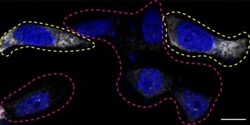
- Experimental details
- Immunofluorescence of Ataxin 2 was performed using parental and Ataxin-2 HAP1 CRISPR KO cells that were transfected with a GFP or mCherry plasmid, respectively. At 48 hrs post transfection parental and KO cells were mixed and plated to a 1:1 ratio on coverslips as a mosaic and incubated for 24 hrs. Cells were fixed in 4% PFA for 15 min and permeabilized with 0.1% Triton X-100. Cells were stained with Ataxin polyclonal antibody (Product # PA5-54183) overnight at 4 deg. Secondary antibody incubation was performed using 1 µg/mL of goat anti-rabbit IgG (H+L) Alexa Fluor 555 secondary antibody (Product # A-21429) for 1 hr at RT. Imaging was performed with a 40X oil objective and analysis was performed using Image J. Cell image represents a single focal plane. Data courtesy of YCharOS Inc., an open science company with the mission of characterizing commercially available antibodies using knockout validation.
Supportive validation
- Submitted by
- Invitrogen Antibodies (provider)
- Main image
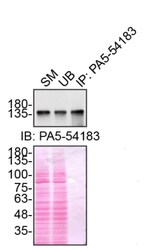
- Experimental details
- Immunoprecipitation of Ataxin was performed on HAP1 cell lysates. Antibody-bead conjugates were prepared by adding 1 µg of Ataxin polyclonal antibody (Product # PA5-54183) with 30 µL of protein A -Sepharose beads and rocked overnight at 4 deg. 1 µg of lysate was incubated with antibody-bead conjugate for 2 hrs at 4 deg. After multiple washes, 10% starting material (SM), 10% unbound fraction (UB) and immunoprecipitated fraction (IP) were processed for immunoblot using the same ATXN antibody (Product # PA5-54183). Ponceau stained transfer of blot is shown. Data courtesy of YCharOS Inc., an open science company with the mission of characterizing commercially available antibodies using knockout validation.
Supportive validation
- Submitted by
- Invitrogen Antibodies (provider)
- Main image
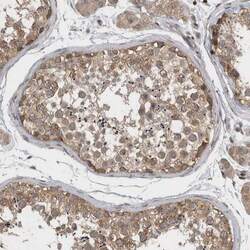
- Experimental details
- Immunohistochemical staining of Ataxin 2 in human testis using Ataxin 2 Polyclonal Antibody (Product # PA5-54183) shows moderate to strong cytoplasmic positivity in cells in seminiferous ducts.
- Submitted by
- Invitrogen Antibodies (provider)
- Main image
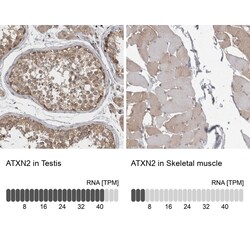
- Experimental details
- Immunohistochemical staining of Ataxin 2 in human testis and skeletal muscle tissues using Ataxin 2 Polyclonal Antibody (Product # PA5-54183). Corresponding ATXN2 RNA-seq data are presented for the same tissues.
- Submitted by
- Invitrogen Antibodies (provider)
- Main image
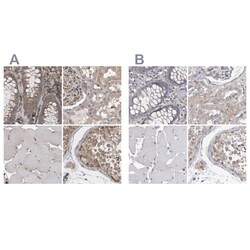
- Experimental details
- Immunohistochemical staining of Ataxin 2 in human colon, kidney, skeletal muscle and testis using Ataxin 2 Polyclonal Antibody (Product # PA5-54183) (A) shows similar protein distribution across tissues to an independent Ataxin 2 Polyclonal Antibody (B).
- Submitted by
- Invitrogen Antibodies (provider)
- Main image
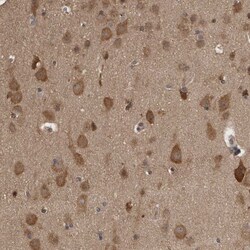
- Experimental details
- Immunohistochemical staining of Ataxin 2 in human cerebral cortex using Ataxin 2 Polyclonal Antibody (Product # PA5-54183) shows moderate to strong cytoplasmic positivity in neurons.
- Submitted by
- Invitrogen Antibodies (provider)
- Main image
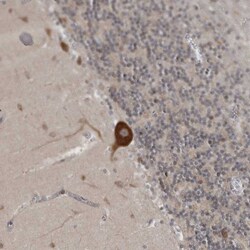
- Experimental details
- Immunohistochemical staining of Ataxin 2 in human cerebellum using Ataxin 2 Polyclonal Antibody (Product # PA5-54183) shows moderate to strong cytoplasmic positivity in purkinje cells.
- Submitted by
- Invitrogen Antibodies (provider)
- Main image
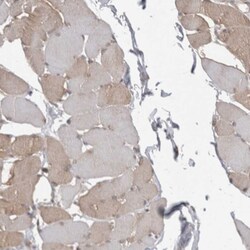
- Experimental details
- Immunohistochemical staining of Ataxin 2 in human skeletal muscle using Ataxin 2 Polyclonal Antibody (Product # PA5-54183) shows weak to moderate cytoplasmic positivity in a subset of myocytes.
- Submitted by
- Invitrogen Antibodies (provider)
- Main image
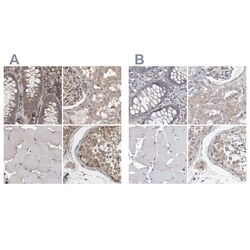
- Experimental details
- Immunohistochemical staining of Ataxin 2 in human colon, kidney, skeletal muscle and testis using Ataxin 2 Polyclonal Antibody (Product # PA5-54183) (A) shows similar protein distribution across tissues to an independent Ataxin 2 Polyclonal Antibody (B).
- Submitted by
- Invitrogen Antibodies (provider)
- Main image
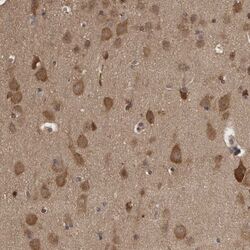
- Experimental details
- Immunohistochemical staining of Ataxin 2 in human cerebral cortex using Ataxin 2 Polyclonal Antibody (Product # PA5-54183) shows moderate to strong cytoplasmic positivity in neurons.
- Submitted by
- Invitrogen Antibodies (provider)
- Main image
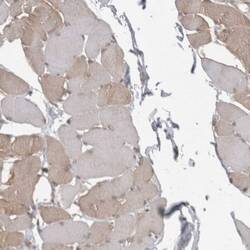
- Experimental details
- Immunohistochemical staining of Ataxin 2 in human skeletal muscle using Ataxin 2 Polyclonal Antibody (Product # PA5-54183) shows weak to moderate cytoplasmic positivity in a subset of myocytes.
Supportive validation
- Submitted by
- Invitrogen Antibodies (provider)
- Main image
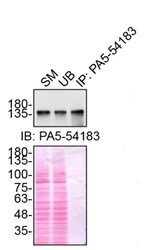
- Experimental details
- Immunoprecipitation of Ataxin was performed on HAP1 cell lysates. Antibody-bead conjugates were prepared by adding 1 µg of Ataxin polyclonal antibody (Product # PA5-54183) with 30 µL of protein A -Sepharose beads and rocked overnight at 4 deg. 1 µg of lysate was incubated with antibody-bead conjugate for 2 hrs at 4 deg. After multiple washes, 10% starting material (SM), 10% unbound fraction (UB) and immunoprecipitated fraction (IP) were processed for immunoblot using the same ATXN antibody (Product # PA5-54183). Ponceau stained transfer of blot is shown. Data courtesy of YCharOS Inc., an open science company with the mission of characterizing commercially available antibodies using knockout validation.
 Explore
Explore Validate
Validate Learn
Learn Western blot
Western blot